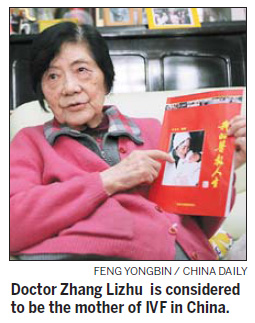Focus
Conceiving a dream, delivering a reality
By Wang Yan and Duan Yan (China Daily)
Updated: 2010-11-02 07:52
 |
Large Medium Small |

CHANGSHA / BEIJING - Chinese doctors had just begun to study human embryos when the world's first "test tube baby", Louise Brown, was born in Britain in 1978.
The "cultural revolution" (1966-76) had just come to an end and Lu Guangxiu, one of the pioneers of in vitro fertilization (IVF) technology in China, recalled how she could hardly find any research material.
"In 1980, my father (Lu Huilin) brought up the idea of test tube babies in China, in the hope of increasing the national power," said the doctor. "Back then, China was very poor, with the nation dubbed 'the sick man of Asia'."
Meanwhile that year, Zhang Lizhu, another trailblazer, was asked to speak on China's family planning policy at the Second World Conference on Women in Copenhagen, Denmark. It was an event that thrust the Peking University professor into the public eye.
Shortly after, letters started arriving from couples across the country, each highlighting the pain of infertility and the desperate search for a solution. By the time Zhang began her IVF research in earnest in 1986, she had received more than 6,300 letters.
Zhang took on the mission as part of a collaborative group that included Peking University No 3 Hospital, Central South University's school of medicine in Changsha, capital of Hunan province, and Peking Union Medical College Hospital. Each received a share of 100,000 yuan ($14,000) put aside by China's National Natural Science Foundation.
Conditions early on were far from ideal, however.
"I had distilled water (from the faucets) five times but it was still too dirty (for the tests) because of the heavily polluted rivers and lakes," said Lu at Central South University, who worked in a 2-square-meter area enclosed by hanging coats. "To sterilize the area I kept a stove burning at all times, which kept the temperature at 40 C."
Scientists on Zhang's team, meanwhile, had to put test tubes filled with follicular fluid from patients into a thermos container and then run across Peking University's sports ground to the laboratory.
Fortunately, the poor facilities did not stop the research and, on the morning of March 10, 1988, the first "test tube baby" born in China was delivered at Peking University No 3 Hospital. The girl was named Zheng Mengzhu. A second baby was born at the hospital in May, with a third and fourth delivered in June at Xiangya Hospital in Changsha.
"We talk with reporters often," said 22-year-old Zhang Minxing, the third test tube baby, who now works at Xiangya Hospital. "The earliest interview I can remember was when I was about 10."
She added that the most common questions she is asked is "Do you think you are different from others?" and "How do other people see you?"
"I never know what to say," said the college graduate, who now researches stem cells. "I don't see myself as different from others."
Since the two Changsha babies were born, Dr Lu has worked tirelessly to protect their privacy and carefully vets all interview requests from the media. Peking University No 3 Hospital also handles the press for Zheng Mengzhu (staff said the hospital has lost contact with the second child born through IVF), with most interview requests turned down.
"She's a normal kid who is growing up like others," said Qiao Jie, director of the hospital's reproductive medical center. "She should be allowed to enjoy a normal life."
Wang Yan reported from Changsha. Duan Yan reported and wrote the story from Beijing.
China Daily